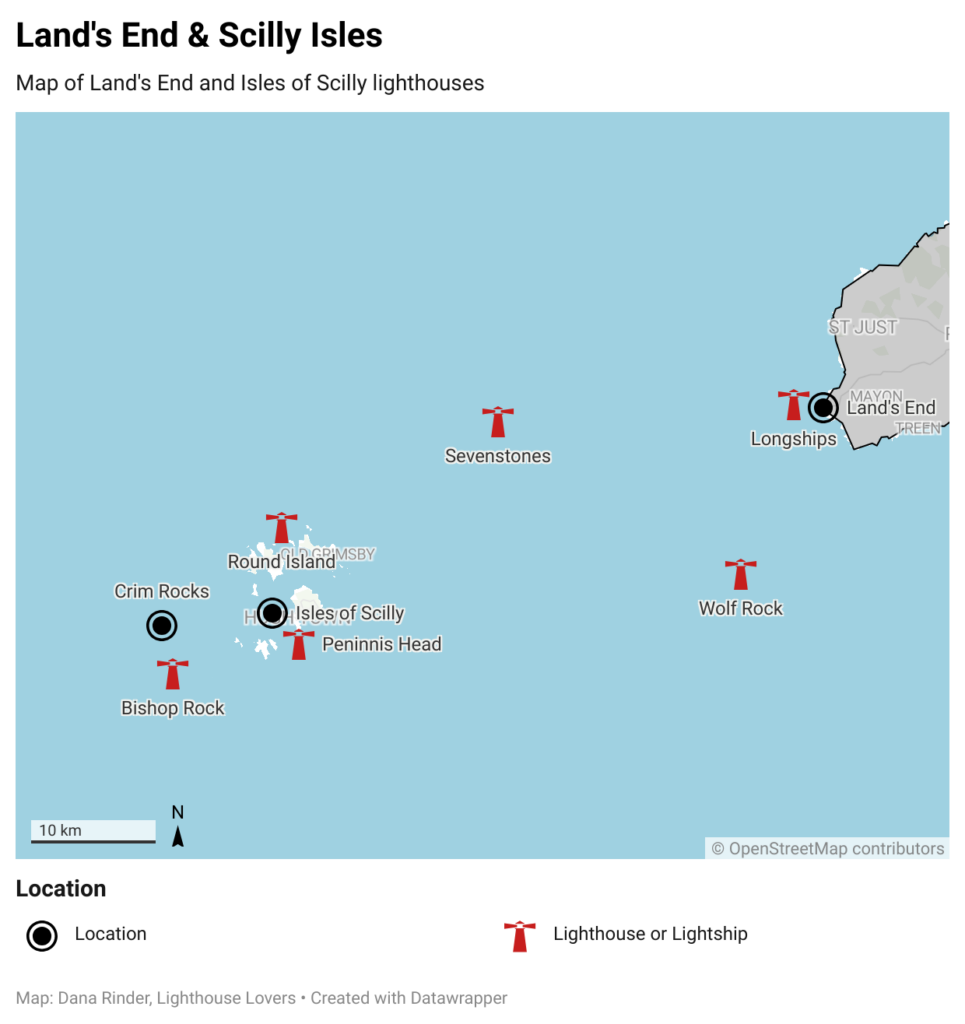Wolf Rock Lighthouse
the first with helipad
The idea of building a lighthouse for the dangerous, frequently submerged reef between Land’s End and the Isles of Scilly was first conceived as early as 1791. However, it wasn’t until several failed attempts with day beacons and an eight-year construction period that the ambitious project finally came to fruition. And it’s been worth the wait! A recent incident involving a cargo vessel serves as a testament to the crucial need for this lighthouse in these treacherous waters.
Wolf Rock Lighthouse
Between Land's End and the Isles of Scilly, Cornwall, United Kingdom
Celtic Sea
Visited Land's End several times, last in June 2024. The offshore lighthouse cannot be visited.

The map above shows just how exposed the location of Wolf Rock Lighthouse is, right in the middle of the ocean between Land's End and the Isles of Scilly. It's a challenging area of sea, but the good news is that it has six lighthouses to help keep sailors safe on their way!
Facts & figures
Wolf Rock Lighthouse sits on a single rock about 10 miles (15 km) off the coast of Land’s End and about 21 miles (33 km) east of St. Mary’s, Isles of Scilly. It was built in 1869 to mark a notoriously hazardous reef that is often submerged by water.
The tower, made of Cornish granite, is 41 metres high and can be seen from the mainland near Land’s End. The lighthouse was the first in Britain to be fitted with a helicopter pad on top of the lantern housing in 1972.
Due to the harsh weather conditions and the exposed location on a submerged reef, it took eight years to build the lighthouse. Plans to erect a lighthouse on Wolf Rock were first mooted in 1791, but the project was soon abandoned as too expensive and too difficult. Instead a lighthouse was constructed on the less exposed Longships, 1.5 miles (2 km) off the coast of Land’s End.
The name Wolf Rock is derived from the howling sound made by the waves as they were forced through a fissure during gales.
Earlier Seamarks - washed away by the sea
A lighthouse on Wolf Rock was too expensive, so an unlit daymark was put up instead in 1791. It had a wrought-iron mast with a metal wolf on top. It didn’t last. By 1795, the daymark was wrecked by the Atlantic gales. Other lighthouses on the rock also failed.
The last beacon, constructed 1836–1840, is still there today. It was more stable. The cone was made of iron and cement and was nearly five metres wide and high. Building on the rock was difficult because it was often underwater. In five years, only 302 hours’ work were done. But the beacon was finished and is still there!
195-metre cargo vessel grounded on Wolf Rock
In an unexpected turn of events, the 195-metre cargo vessel Mazarine lost power and made an unexpected stop near the Wolf Rock Lighthouse on 10 July 2023. In a heartening display of heroism, four RNLI lifeboats from Sennen Cove, Penlee, The Lizard and Falmouth lifeboat stations, with a total of twenty-eight RNLI crew onboard, launched to assist the ship. Thankfully, the Marazine just managed to clear the rock! Unfortunately, it was unable to start the engines and drifted towards Mount’s Bay.
In the end, a tug came to the rescue and towed the casualty safely to Falmouth Bay. Some of the lifeboats remained on the scene for nearly six hours, providing safety cover and ready to respond at a moment’s notice. Some of them even escorted the vessel all the way to Falmouth Harbour! Some of the crews had been out on the sea all day, braving the elements, before returning to their stations after midnight.
And there’s more! You can read the full report of this event on the RNLI website. You can even watch the video of the rescue operation there.

In a daring rescue mission, the lifeboat from Sennen Cove sets out with a crew of seven men to help the cargo vessel
Mazarine, which has run aground at Wolf Rock. Credit: RNLI
Unpopular with keepers
Wolf Rock was known to be a very unpopular lighthouse with keepers as boat reliefs were often delayed.
In January 1948 severe storms hit the south coast, making it impossible to relieve the lighthouse. The keepers were 22 days overdue and managed to signal to the passing ship ‘Scillonian’ that they urgently needed supplies. A helicopter finally brought supplies on 5 February, but it would be another ten days before the keepers could be relieved.
Tragedy struck on 18 December 1969 when a keeper was swept from the platform around the base of the tower while fishing. His body was never recovered.
Since Wolf Rock Lighthouse became the first lighthouse in Britain with a helicopter landing pad, the reliefs were made more reliable.
Nowadays the lighthouse has no keepers. It was automated in 1988.
You Can't Get enough?
Here you can find some of the other lighthouses that I have visited.











